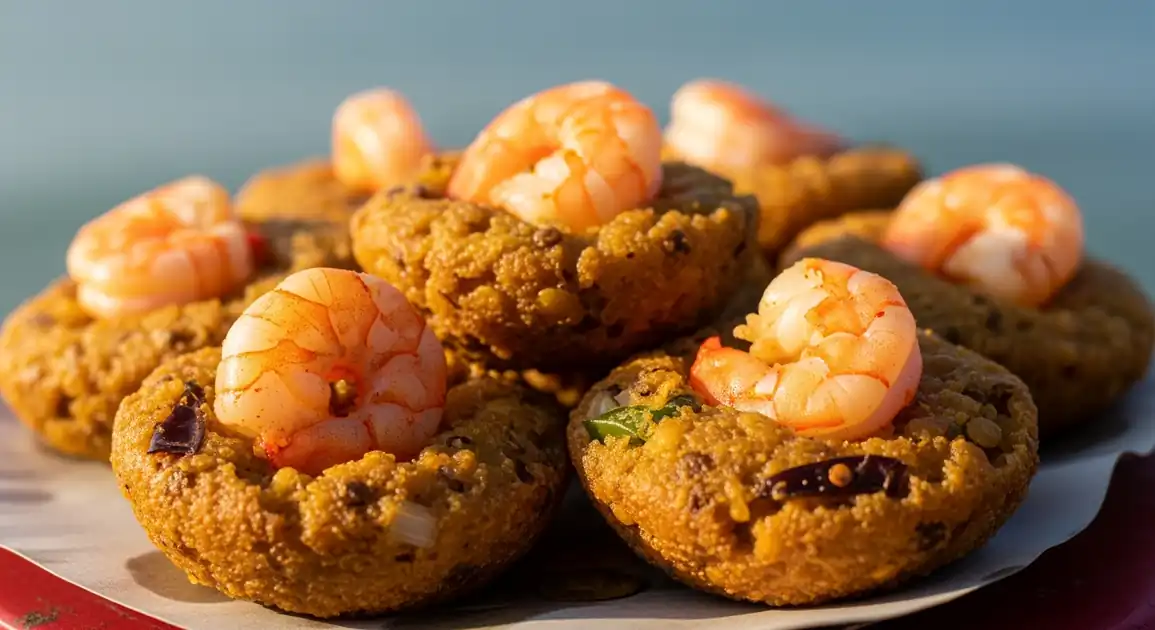Isso Wade (Prawn Fritters)
ඉස්සෝ වඩේ

Description
Isso Wade is a quintessential Sri Lankan street food, found most prominently in coastal cities and towns where fresh prawns are readily available. While Colombo's Galle Face Green is the most famous spot, variations are enjoyed across the island, especially as an evening snack from mobile vendors.
Dietary Information
Serving information
Serving style
Served hot, usually handed over wrapped in a small piece of paper or put in a small paper bag. Eaten by hand immediately.
Quick facts
Mainly Late Afternoon to Evening (approx. 3 PM - 9 PM).
Safety Tips
What to Look For
-
Vendor frying fresh batches ('thenēma badina')
Ensures the wade is hot, crispy, and the prawn is freshly cooked, minimizing risks associated with pre-cooked seafood sitting out.
-
Hot, bubbling, reasonably clean frying oil
Hot oil cooks quickly and effectively. Avoid excessively dark, sludgy, or smoking oil which affects taste and safety.
-
Busy vendor with high turnover
Indicates popularity and that ingredients, including prawns, are likely fresh and not sitting around for too long.
-
Prawns appear fresh and plump
Check the appearance of the prawns on the uncooked patties or finished product. They shouldn't look dull, discolored, or overly dry.
-
Clean cart, utensils, and handling
General cleanliness is a good sign. Look for use of tongs or paper to handle cooked wade.
What to avoid
-
Large piles of pre-fried wade sitting for a long time
Increases risk of bacterial growth, especially with seafood. Wade also loses its crispness quickly.
-
Very dark, dirty, or old-looking frying oil
Affects flavor negatively and may contain harmful compounds.
-
Visible flies around the food or cart
Flies are carriers of bacteria and indicate poor hygiene.
-
Prawns look dull, discolored, or smell off
Clear signs that the seafood may not be fresh or safe to eat.
-
Vendor handling money then food without cleaning hands/using utensils
High risk of cross-contamination.
Price information
Price range
Budget tips
- Prices are generally low, typically 60-100 LKR per piece from street carts.
- Prices might be slightly higher in very touristy beach areas.
- Buying several pieces at once might offer slightly better value.
Value indicators
- Crispiness (freshly fried).
- Decent sized, fresh prawn(s).
- Good balance of spice and flavor in the wade.
- Not overly oily.
Where to Find This Dish
Coastal Promenades/Beaches
High concentration of vendors in places popular for evening strolls.
Galle Face Green (Colombo), Mount Lavinia Beach, Hikkaduwa Beach, Unawatuna Beach
Evening
Busy Town Centers/Junctions
Mobile carts often position themselves in areas with high foot traffic.
Near bus stands, Train stations
Late Afternoon, Evening
Vendor Tips
- Look for the characteristic sizzle and smell of frying – follow your senses!
- Observe if locals are buying from a particular vendor – usually a good sign.
- Don't be afraid to ask for one to be fried fresh ('aluthen badinna') if you see only pre-cooked ones.
How to Order
Regional Variations
-
Standard Isso Wade
(ඉස්සෝ වඩේ)
The classic version: spicy lentil fritter topped with one or two prawns.
-
Parippu Wade (No Prawns)
(පරිප්පු වඩේ)
The base fritter served plain, without the prawn topping. Also a very popular street food.
-
Spice Level Variation
(සැර වෙනස්කම්)
While usually spicy, the exact heat level can vary slightly between vendors depending on the amount of chili used.
-
Prawn Size/Type
(ඉස්සෝ ප්රමාණය/වර්ගය)
The size and preparation of the prawn (head on/off, peeled/unpeeled) can vary slightly.
Cultural context
History
Isso Wade likely evolved as a variation of the simpler Parippu Wade (lentil fritter), adding prawns readily available in coastal Sri Lanka to create a more substantial and flavorful snack. It gained immense popularity through mobile street vendors, particularly those frequenting Galle Face Green in Colombo, becoming synonymous with evening strolls by the sea. It represents the island's love for 'short eats' (savory snacks) and spicy flavors.
Local significance
An iconic Sri Lankan 'short eat', representing casual street food culture and the island's connection to the sea. It's a beloved snack enjoyed by people from all walks of life.
Eating customs
- Eaten hot and fresh, usually standing near the vendor's cart.
- Consumed by hand.
- The entire prawn (sometimes including the shell, depending on preparation) is often eaten.